Table of contents
- Manufacturer statements on the subject of motorcycle noise Flap exhaust, Euro 5b, new measuring methods
- Manufacturers have so far held back in discussions about motorcycle noise
- MOTORCYCLE questionnaire for manufacturers
- Conclusion
Motorcycle noise
Debate about the volume of motorcycles
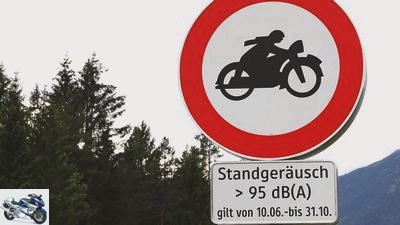
Astrid Gast – stock.adobe.com
counselor
traffic & business
Manufacturer statements on the subject of motorcycle noise
Manufacturer statements on the subject of motorcycle noise
Flap exhaust, Euro 5b, new measuring methods
For the first time, manufacturers speak out in the debate about motorcycle noise. Despite partly different perspectives, one thing can be read very clearly from all of the statements: there will be no quick and easy solutions.
Eva Breutel,
Michael Schumann
08/20/2020
The wind is blowing us motorcyclists pretty hard in the face in the memorable year 2020: Driving bans in Tyrol, excited discussions about motorcycle noise in Germany, more and more road closures dangerous speed limits (Tempo 60 only for motorbikes in Trentino). The regulations against motorcycles planned or already implemented in Central Europe are increasing – that is not a good idea.
The German Federal Council kicked off with its in mid-May “Initiative against motorcycle noise” fired, in which, among other things, there is talk of driving bans for noise protection reasons. Shortly afterwards, on June 10th, the Austrian state of Tyrol imposed a coup d’etat on some popular routes Driving bans for bikes with more than 95 dB (A) standing noise (MOTORCYCLE 15/2020). The motorcyclists reacted promptly and organized in Germany and Austria impressive demos for her hobby (MOTORCYCLE 16/2020). The scene is in turmoil – and so too Parties, politicians and various interest groups take a stand in the often heated debate.
Manufacturers have so far held back in discussions about motorcycle noise
Only with a not insignificant number of those affected has there been a deep silence so far: the motorcycle manufacturers have acted quietly and, in rare unanimity, have renounced any public statement. “We can only lose on this issue, no matter what we say”, it was said by a press office to justify it. But MOTORRAD did not give up and presented the most important manufacturers on the European market with a detailed catalog of questions on the subject. But not all of them wanted to get out of the way: Indian and Suzuki did not come up with any answers, others – namely Ducati, Harley-Davidson and Honda – only sent brief, not very meaningful blanket statements. In numerous background discussions that MOTORRAD also conducted, however, it became clear that the entire industry had heard the warning shot and is now dealing more intensively than before with the subject of noise. But there will be no quick solutions because the development cycles for new motorcycles are between three and five years. Changes in the noise level would have to be taken into account in the budget, but that has long been clear for the next innovations. In addition, the noise debate is currently limited primarily to Northern and Central Europe. It is quite conceivable that one or the other manufacturer will reduce its commitment here and instead expand it in Asia and South America.
BMW Motorrad boss Markus Schramm and KTM / Husqvarna boss Stefan Pierer, the latter in his role as president of the European manufacturers’ association ACEM (Association des Constructeurs Europeens de Motocycles), gave the most detailed answers. Perhaps it is because of the geographical proximity to the focal point of Tyrol that the Bavarian and Austrian are particularly committed. With good reason, because in Tyrol an initial interim report by the state government says that the noise driving ban has proven itself: Many residents have the feeling that it has become quieter on the streets. Apparently there are now even considerations to extend the ban, which so far only applies on some routes in the Reutte district near the border with Germany, to other areas in Tyrol, for example in the direction of Otztal or Achensee. Similar declarations of intent come from other Austrian federal states. In Switzerland, northern Italy and southern France, too, there are increasing voices calling for further restrictions on motorcycles, and Germany, with the heated noise debate, could soon no longer be a good place for motorcyclists.
But if there are no quick fixes, what happens next? BMW boss Schramm makes those involved responsible: “We all want to enjoy freedom on two wheels – undisturbed, but also without disturbing others. This requires the assumption of joint responsibility: by manufacturers who are responsible for technology development, by motorcyclists who drive disciplined and considerate, and by the police and authorities who ensure compliance with existing laws.”
MOTORCYCLE questionnaire for manufacturers
We sent the following questions to all manufacturers. They dealt with it amazingly differently. The bandwidth ranged from extensive answers with future procedures and a concrete proposal published for the first time for the new measurement method to complete ignoring.
- Is manufacturer X planning to react to the issue of combustion motorcycles and volume, and if so, how should that be done in concrete terms?
- Are there short-term solutions from manufacturer X, e.g. with post-homologated exhaust systems?
- Manufacturer X can imagine doing without the controversial flap exhaust systems in the future?
- Does manufacturer X advocate a redefinition of the noise measurement range in the course of the upcoming Euro 5-B regulation, e.g. over a significantly expanded range of driving conditions? And if so, what should this measuring range look like in the future?
That’s what the manufacturers say
BMW:
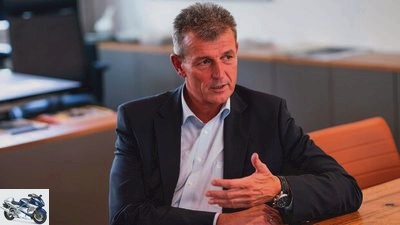
BMW
Markus Schramm, Head of BMW Motorrad
BMW is planning to respond to the issue of combustion engine motorcycles and volume, and if so, how should that be done in concrete terms?
The topic “Motorcycle sound and volume” is too complex for a simple answer. That motorcycles in certain areas as “noisy” perceived, can be due to manipulated or non-type-approved silencer systems, to the unsocial driving style or simply to a high number of motorcyclists per route at the weekend. Is it justified to punish all motorcyclists for the misconduct of individuals? The debate is emotionally charged, facts take a back seat. Of course, as a manufacturer, we also take our share of the responsibility seriously. We don’t define the sound of motorcycles by volume, but by the character of the sound. We take the reductions in noise emissions discussed by the legislator very seriously.
Would short-term solutions be conceivable, e.g. B. with post-homologated exhaust systems that are quieter?
As a manufacturer, we are dependent on legislation that is as long-term as possible. Development cycles of four to five years simply leave no possibility of meeting short-term requirements such as the time-limited ones Noise regulations in Tyrol to react. In addition, the Tyrolean regulation refers to the stationary noise measured value, for which there is no limit value and which has no relevance for the type approval of a motorcycle. This value is measured at a distance of 50 centimeters from the silencer and also has only a very limited informative value for the driving noise.
BMW is planning to forego the use of the controversial flap exhaust systems in the future?
We consider the problem of reducing the use of exhaust flaps to be too one-sided. At BMW Motorrad, the exhaust flaps are not actuators that are open or closed. Rather, the flaps have a far-reaching influence on drivability, gas exchange behavior and of course acoustics. Correspondingly, the flap is activated depending on the gear by an elaborately coordinated map, and this is not open or closed, but also in the required intermediate positions from the point of view of the gas exchange. The final flap map will be disclosed by BMW in the course of approval.
It would be conceivable to be very quiet “Urban”-To program mode with significantly reduced noise emissions?
It is too early to talk about detailed technical solutions at this point.
Does BMW advocate a redefinition of the noise measurement range in the course of the upcoming Euro 5b regulation, e.g. B. over a significantly expanded range of driving conditions?
Definitely: yes. Together with the manufacturer colleagues and in exchange with the legislators, we are working on proposals that regulate the “Real Driving Sound Emissions” to improve. Currently, the proposals to improve the ASEP regulations (Additional Sound Emission Provisions) include: the expansion of the speed range to be tested to 10 to 100 km / h – and thus also at higher speeds – as well as testing in all gears. Only tests that reasonably simulate the real use of a vehicle also show noticeable improvements for the environment.
Ducati (Vincenzo De Silvio, Technical Director): All of our current models adhere to the applicable standards of the countries in which they are sold. Of course, we are aware of the current noise debate. We are in the process of developing solutions that go beyond the legal norms.
Harley-Davidson Motor Company (Dan Lovis, International PR and Content): Harley-Davidson works with other manufacturers and the members of the European Manufacturers Association ACEM to ensure that we always meet both the needs of the citizens and the requirements of the law.
Honda Germany (Takao Ito, General Manager Motorcycle): With our industrial partners in ACEM, Honda is working closely with the EU institutions to continue offering the best approach to reforming noise legislation. The current position of ACEM fully supports Honda.
Kawasaki Germany:
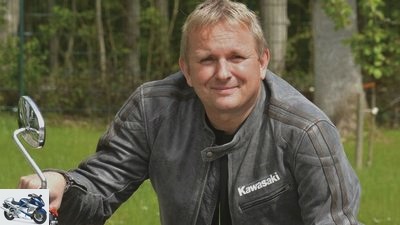
Kawasaki
Jurgen Hopker-Seibert, Head of Sales at Kawasaki Germany
Kawasaki attaches great importance to the intake noise, it offers the driver an emotional sound without polluting the environment with excessive volume. Furthermore, our compressor motorcycles of the H2 series with their unique sound are absolutely in the green. Compressor technology in particular has great advantages when it comes to exhaust noise, which, however, is partially canceled out by the mechanical noise of the charger. Still, there is great potential here.
Most Kawasaki models are not affected by the regulation in Tyrol. We already have a number of accessory systems in our range, for example for the Z 900, which are somewhat quieter than the original system. Regarding the flap exhaust: It not only has the side effect of volume, but is also of central importance for the coordination of the motorcycle in terms of performance and emissions. Here the central questions for us are what the legislator expects and how the customer behaves. The addressed quietly “Urban”-Modus is an interesting option, but it must be checked for technical feasibility: Throttled engines often have significantly poorer CO2 values. If you reduce speed or power, you have a quieter vehicle, but it generates significantly higher emissions in this mode. Nevertheless, this is a concept our development department is thinking about. As far as the upcoming Euro 5b regulation is concerned, Kawasaki stands by the proposal drawn up by the IVM and ACEM (see below “That’s what the ACEM says”, Red.). It is balanced, takes into account all operating conditions and various driving behaviors.
MV Agusta:

MV Agusta
Brian Gillen, R.&D boss MV Agusta
The sound is extremely important for our motorcycles because it contributes greatly to their emotionality. The development at MV Agusta aims to reduce the noise to an absolute minimum in order to emphasize the actual sound even more. Motorcycles have many different sources of noise, which we always keep an eye on and constantly re-evaluate in order to offer our customers motorcycles that respect international and local noise limits. We mainly use flap systems to control the torque and driveability of our motorcycles. We intend to keep this technology in order to offer as many drivers as possible the best driving characteristics for them. What a particularly quiet one “Urban”-As for Modus: We would have to know which noise level we are aiming for in order to be able to evaluate the feasibility. Regarding the question of Euro 5b homologation: The current Euro 5 test procedures for noise measurement are very precise and include all noise sources of a vehicle. That is why we support the current regulation.
Piaggio Group (with the brands Aprilia, Moto Guzzi and Vespa): In the ongoing noise discussion, the Piaggio Group is based on the European manufacturers’ association ACEM. The one brought into play by MOTORRAD, particularly quiet “Urban”-Modus is technically feasible and could be one of the possible solutions. However, we want all manufacturers to have a uniform position, both with regard to short-term solutions and the definition of future homologation regulations. The problem is important and therefore deserves a joint response from the European motorcycle industry so that the solutions can then be implemented efficiently.
Triumph Germany:

triumph
Natalie Kavafyan, General Manager Triumph Germany and Austria
There are a number of possible short and long term technical options for noise reduction, but the final solution will depend on the criteria that need to be met. Of course, responsible manufacturers will always design within the existing regulations. Therefore, questions about noise should ideally be addressed by agreeing appropriate levels and test procedures that all manufacturers can work on.
What we now z. Am Tyrol see is a local initiative that was introduced on the basis of a subjective survey and without prior notice. We would have liked a coordinated European approach here and, above all, with a timeline that also allows manufacturers to react accordingly.
Yamaha Motor Germany:
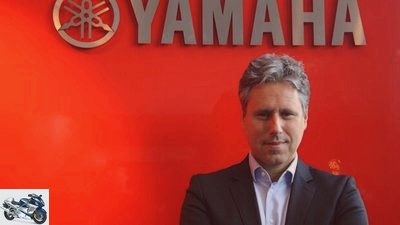
Yamaha
Marcel Driessen, Country Manager Yamaha Motor Germany
At Yamaha we do not use flap exhaust systems; our motorcycles comply with the limit values for noise measurements even without such a method. If all other manufacturers were to offer vehicles that already met the regulations ex works without the use of the controversial flap exhaust systems, that would be a very important step in the right direction. In addition, it must be ensured that accessory exhaust systems also comply with the limits and that no modifications are made that are not permitted in road traffic. A particularly quiet one “Urban”-In our opinion, mode is not the right solution: Such a quiet mode would automatically mean that there is also a louder mode.
The rules on noise emissions are already very strict and Euro 5b will make them even stricter. A correctly homologated motorcycle with a rider who adheres to the applicable maximum speeds will not be perceived by others as a nuisance. But you always have to be realistic and remember that you cannot compare a motorcycle with a car when measuring noise. The engine is exposed and the possibilities for large exhaust systems are limited. It is important to understand that the volume on a Euro 5-compliant motorcycle does not necessarily come from the engine alone: the rolling noise or other mechanical noises, for example, play a decisive role.
If we all work together to ensure that the existing and future regulations are complied with 100 percent, the noise pollution will decrease dramatically. When we practice our hobby, we share the road with others. We must not destroy this freedom by neglecting others.
This is what ACEM (European Association of Motorcycle Manufacturers) says
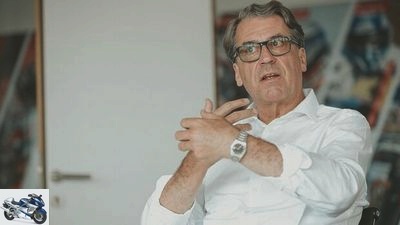
KTM / Emanuel Tschann
Stefan Pierer, ACEM President and Head of KTM and Husqvarna. He answered our questionnaire in his role as ACEM President, not as KTM / Husqvarna boss.
ACEM is planning to respond to the issue of combustion motorcycles and noise levels, and if so, how should that be done in concrete terms?
As an association of the major global motorcycle manufacturers, ACEM has drawn up concrete plans for sustainable and timely measures to combat the volume problem. The association and its members work closely with European legislators to solve the problems that can arise from exceeding the permitted noise limits. While some of the actions taken by the motorcycle industry will have an impact, today’s immediate problems also need to be addressed. The measures taken by motorcycle manufacturers alone are therefore not enough. Corresponding behavior is also required in the field of manufacturers of retrofit silencers and on the national level on the part of the executive and in particular on the part of motorcyclists themselves.
Does the ACEM advocate a redefinition of the noise measurement range in the course of the upcoming Euro 5b regulation, e.g. B. over a significantly expanded range of driving conditions?
After several years of intensive work, the motorcycle industry will present its proposal for the ASEP 2.0 test procedure to the United Nations Economic Commission for Europe (UNECE) in Geneva this year. In contrast to the current method, there are no specifications regarding the entry conditions into the measuring section. So far, only operating states with fully open throttle grip have been tested; the new procedure also enables tests with partially open throttle grip position. While in the previous method four operating states are checked in either second, third and / or fourth gear, two of which were not known to the vehicle manufacturer before the test, the new method provides for three tests in each of the existing gears of the vehicle, driven at one speed between 10 and 100 km / h, whereby the manufacturer does not know the operating conditions before the test. ASEP 2.0 is therefore significantly more representative of the driving conditions in real road traffic and ensures the avoidance of unacceptable noise levels outside the framework conditions of the measurement process.
It is now up to the legislative institutions in Brussels to include these improved test procedures in the European regulations for type approval. The next opportunity for this is the Euro 5b regulation you mentioned.
Conclusion
We will continue to exercise our hobby, our passion, and defend ourselves against anti-motorcycle campaigns and other injustices. But we also need to be considerate of others. And the manufacturers have now understood that too. We are curious to see how EU legislation will take up the new ACEM proposal and incorporate it into the homologation regulations. The issue of retrofit exhaust systems must also be addressed. We literally have the rest in our own hands.
Related articles
-
Statements on the subject of motorcycle noise: that’s what stakeholders say
Motorcycle noise Debate about the volume of motorcycles Michael Schumann counselor traffic & business Statements on the subject of motorcycle noise:…
-
Motorcycle noise initiative in B-W and interview with Minister of Transport
Motorcycle noise Debate about the volume of motorcycles Baden-Wurttemberg Ministry of Transport counselor traffic & business Motorcycle noise initiative…
-
New noise regulation for motorcycles from 2016
Motorcycle noise Debate about the volume of motorcycles Photo: fact 8th pictures Chaqune 1/8 Moto Guzzi driver Holger Siegel is the spokesman for the…
-
Dispute over motorcycle noise: Greens with position paper
Motorcycle noise Debate about the volume of motorcycles Honda counselor traffic & business Dispute over motorcycle noise: Greens with position paper…
-
ADAC opens digital forum on motorcycle noise
Motorcycle noise Debate about the volume of motorcycles Baden-Wurttemberg Ministry of Transport counselor traffic & business ADAC opens digital forum on…
-
Motorcycle exhaust sound design
BMW accesories Exhaust & silencer Motorcycle exhaust sound design Exhaust special Sound hobbyist Content of The sound of our motorcycles is no…
-
IG Moto motorcycle noise volume initiative
Motorcycle noise Debate about the volume of motorcycles Eva Breutel 6th pictures Eva Breutel 1/6 The committed test team of the Austrian IG Moto after…
-
Repair motorcycle tires or not. What is allowed?
5 pictures 1/5 Annoying: screw in the tire and no more inflation pressure. Repairing is legally and technically possible. 2/5 Breakdown assistance…
-
New Bosch motorcycle safety systems
Bosch 17th pictures Bosch 1/17 To make motorcycling even safer, Bosch is developing numerous new assistance systems. Bosch 2/17 Motorcycles should learn…
-
Motorcycle production at Bimota
Jahn counselor traffic & business Motorcycle production at Bimota This is how one of the smallest manufacturers in the world produces Motorcycle…